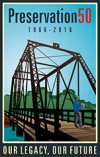 After months of uncertainty, weeks of negotiations and two short-term extensions to keep the government open, Congress passed and the President signed the 2009 page omnibus spending Bill, titled the Consolidated Appropriations Act of 2016. How did federal initiatives that support landscape scale work and fund our natural and cultural conservation program fare?
After months of uncertainty, weeks of negotiations and two short-term extensions to keep the government open, Congress passed and the President signed the 2009 page omnibus spending Bill, titled the Consolidated Appropriations Act of 2016. How did federal initiatives that support landscape scale work and fund our natural and cultural conservation program fare?
The Land and Water Conservation Fund
Ding, Ding, Ding! Only three dings as Congress limited reauthorization of the now 50-year old fund to just three years. However, the good news is that it is still around and with $450 million allocated for the coming fiscal year much good work can be accomplished at the state and national level. Landscape work was specifically recognized in an appropriations for a number of large scale projects including an appropriation for the Rivers of the Chesapeake. This Collaborative Landscape proposal received $11 million for land conservation in the Chesapeake region and $2 million for supporting a range of public access and conservation efforts along the Captain John Smith Chesapeake National Historic Trail. It is estimated that this targeted funding will protect 2,100 acres of land in this threatened watershed.
The Historic Preservation Fund
 Not quite such good news to kick off the celebration of the fiftieth Anniversary of the National Historic Preservation Act. The appropriations bill did not include the reauthorization of the Historic Preservation Fund, which expired on September 30th. 2015. This means that action on a bill (HR 2817) to reauthorize the fund will have to wait till the New Year. However, there was some good news. Overall the bill funds the HPF at $65.41 million, an increase of $9 million over FY15 enacted levels.
Not quite such good news to kick off the celebration of the fiftieth Anniversary of the National Historic Preservation Act. The appropriations bill did not include the reauthorization of the Historic Preservation Fund, which expired on September 30th. 2015. This means that action on a bill (HR 2817) to reauthorize the fund will have to wait till the New Year. However, there was some good news. Overall the bill funds the HPF at $65.41 million, an increase of $9 million over FY15 enacted levels.
The funding breakdown for State and Tribal Historic Preservation Offices is as follows: $46.925 million for SHPOs (equal to FY15 enacted levels), $9.985 million for THPOs ($1 million above FY15 enacted levels), $8 million in grants to preserve the sites and stories of the Civil Rights Movement and $500,000 in grants for underrepresented communities.
The National Heritage Areas
Generally good news as funding remained level at $19,821 million. Since the program has been without strong administration support, just holding on to a level appropriation has been an annual struggle. In addition the 2016 act extended the funding authorization for three areas and increased the funding authorization caps for four other areas. Overall Congress showed an interest in sustaining the program.
One twist to watch is the transfer of $625,000 funding that in the past went to the Blackstone River Valley National Heritage Corridor https://blackstoneheritagecorridor.org from the national heritage areas program account to the new Blackstone Valley Historic Park. As for now the heritage corridor and the new park are working closely together. The heritage corridor’s level of staffing and on the ground facilities like visitor centers are a boon to a park that is just finding its feet. How will blurring of the lines between what has been traditionally been an external program and a new unit of the national park system work out in the long run? Since this is a year-to-year arrangement, we have to wait and see.
The Landscape Conservation Cooperatives
 Five years ago the Department of the Interior launched the Landscape Conservation Cooperatives (LCC) to better integrate science and management to address climate change and other landscape scale issues through collaborative networks that are grounded in science. As one might imagine congressional funding for this program has been a point of contention. Despite threats to severely reduce or even eliminate the program, the final appropriation for the 2016 budget the LCC was only reduced by $1 million in the Cooperative Landscapes account — from $13,988,000 in FY15 to $12,988,0. The LCC budget in the Adaptive Science account remains at the FY15 level — $10,517,000. So the final outcome should be seen as a win for the landscape approach to resource management. To learn more about the LCCs read the just released National Academy report A Review of the Landscape Conservation Cooperatives.
Five years ago the Department of the Interior launched the Landscape Conservation Cooperatives (LCC) to better integrate science and management to address climate change and other landscape scale issues through collaborative networks that are grounded in science. As one might imagine congressional funding for this program has been a point of contention. Despite threats to severely reduce or even eliminate the program, the final appropriation for the 2016 budget the LCC was only reduced by $1 million in the Cooperative Landscapes account — from $13,988,000 in FY15 to $12,988,0. The LCC budget in the Adaptive Science account remains at the FY15 level — $10,517,000. So the final outcome should be seen as a win for the landscape approach to resource management. To learn more about the LCCs read the just released National Academy report A Review of the Landscape Conservation Cooperatives.
Overall this is good news considering the current congressional environment. Can we see any patterns in these encouraging outcomes? Well a few:
- The public sees such programs, particularly the long established ones, as beneficial and conserving the things they care about.
- Advocacy is an essential part of program survival. High marks go to the coalition to reauthorize the Land and Water program. They have had an impressive ground game and media presence.
- While not conclusive, positive evaluations of the program such as the recent study on the LCCs and the reports on the National Heritage Areas might have turned the tide on the funding issue.
Readers do you have any other observation? All good ideas welcomed as next year will not be any easier!
PS If you like the posters celebrating the 50th Anniversary of the National Historic Preservation Act, you can order them at the Preservation 50 web site!


